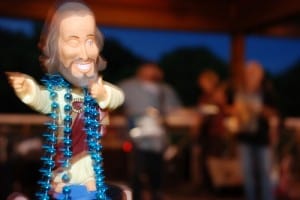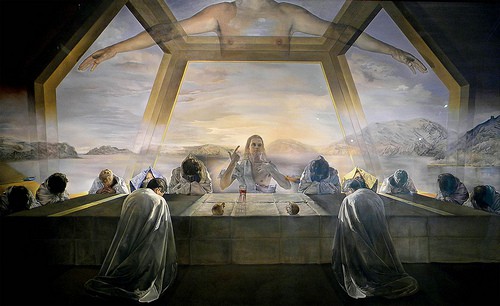It should not surprise regular readers that I am pretty stoked to see the new Superman movie, Man of Steel, in theaters now. However, I have a lingering fear that a whole spate of comments on how Superman somehow embodies elements of the Christ narrative will follow the release of this highly-anticipated summer blockbuster. So…lets say it now: Superman is not Jesus Christ. No. Not even a little.
Not without reason, Superman tends to get put into the “Christ-metaphor” box a little too quickly. Pop culture, being what it is, continues to coopt various parts of the Christian narrative as a way of creating apparent depth and ready-made recognition for various characters. Superman? Human-like, but wielding miraculous power, he embodies the marriage between fantasy and science. His One-part-boy-scout-one-part-ultimate-weapon persona has become an icon for moral justice. Superman has become a secular myth – occupying that mysterious imaginative place where real human impulses get played out in fantastic and epic ways.
As Jesuit literary scholar (and perhaps the most underrated theological mind of the 20th century) William F. Lynch remarks in his book Christ and Prometheus, humanity is constantly in search of a face for itself. We seek some image that might embody our hopes and fears. The limitless potential of the human imagination is constantly in tension with a human will that must be restrained. We look for an icon to guide us toward a brighter future, an icon that will allow us to see human potential in new ways, but will also keep us from the more destructive elements in the human psyche.
The non-religious imagination constantly uses science fiction and fantasy to critique the present and show possibilities for the future. At their best, these visions of alternate realities excite, inspire and even challenge us. At their worst, they just become more examples of how sex and violence get fetishized. Still, these genres are capable of offering hope in human ingenuity, reasonable morality, and scientific thought. Even when they reveal the dark possibilities for what happens when things go wrong, they can still reveal hope like some modern Dickensian ghosts. It is not that the things we see in these movies are providing us with real scientific insight or that the events they describe will ever really happen. Rather, these movies give us freedom to imagine our world as we progress into an unknown and sometimes frightening future.
* * *
Superman has emerged as the alpha and omega of the secular ideal of the good; he is a graphic and literary creation that bears the symbolic weight of the best that the non-religious imagination has to offer. He is one version of what ultimate power, controlled by a sound conscience, might look like. Sound familiar? Perhaps this is why creators from comic artists to film directors have relied upon religious imagery to help convey the depth of his story. In the comic books, there was the notorious saga of the death and resurrection of Superman (including everything from a scene of Lois Lane cradling the Man of Steel like Michelangelo’s Pieta, to a scene where she visits Superman’s empty tomb).1 In more recent years, the epic (and pretty brilliant) graphic novel Kingdom Come emerged, depicting Superman in the battle of Armageddon (amidst a storyline heavily seasoned with quotes from the biblical Book of Revelation). Most recently, the 2006 movie Superman Returns was filled with all types of religious symbolism (just check out this interview with the director, Bryan Singer).
Christian imagery is sometimes used to show how Superman embodies an ultimate secular ideal.2 I am guessing that in order to get their ideas across, non-religious authors go for what they know, what they think will play well. The symbols we use for Jesus have become so much a part of the culture, it is not surprising that authors might borrow from the story. The religious elements in Superman’s story appear as a way of creating awe and wonder. No, he is not The Lord, but he is a kind of savior. Like some gnostic Christ, Superman is not of this world, but he offers a model for how one with ultimate power might act. He embodies a non-religious, moral ideal. He is a secular god….really.
* * *
Supposedly, the new movie is going to attempt to show the conflicted, more human side of Superman. The thing is, we do not really watch Superman because he is accessible as a human being. I mean, for starters, he is not even human. He is Kryptonian. But more so, where other characters (Batman, Spider-Man, Iron-Man) have been fashioned and refashioned to bear the darker or more fragile elements of human existence, Superman has never really been imagined compellingly in this way. In the first twenty years of his existence, his creators did everything in their power to show how he was much, MUCH, more than a regular guy. In fact, they had to invent Kryptonite because he became so powerful that nothing could really hurt him. Even in the current era when he is somehow wounded or faces an ultimate trial of some sort, there is never any doubt that he will succeed. Along with this invulnerability, he is always an embodiment of a higher sort of virtue that seems to be as much a part of his amplified DNA as the rest of his abilities. He is always, and flawlessly, the perfect humanoid according to the popular interpretation of the era he is in. While we might be presented with ways we might be like him, his success lies in the fact that there is no way we could ever become him.
In some ways, Superman stories are still more accessible to our modern culture than stories of Jesus Christ. Why? Because “following” Superman, or any sci-fi superhero character for that matter, allows us to suspend our disbelief and let our imaginations wander. We see right and wrong, good and bad, playing themselves out in epic ways and we get to be the judge. We are free to imagine the story of Superman in any way we can, provided we follow certain rules. When those rules get bent a little, we still like to watch what happens because it is all about creativity and imagination. When things get a little strange, it does not matter because its only make-believe. There is no absolute and overarching moral belief that must be maintained. There is no formula that must be followed. Provided the basics are intact (he has an S on his chest, shoots heat beams, and has an arctic fortress) we are free to feast our senses and let our imaginations move as they will.
* * *
Why not just turn to the story of Jesus himself? Probably because a risen-from-the-dead, fully-human-and-fully-divine-Son-of-God-like-us-in-all-ways-but-sin is a hard story to relate to. The nuances of the story that is revealed by Christian scripture, Catholic dogma, and traditional images get a little difficult to explain. I mean, we do try. In popular iconography, a simple internet search reveals Jesus as a shepherd, a king, a carpenter, comforting the sick, holding those afflicted with drug addiction, arm-wrestling Satan, playing the electric guitar, holding a machine gun, and (even) dressed as Superman. The list could go on.
Embodied in ten thousand faces not His own, with each one conveying a story that different people in different contexts might find accessible, the symbol of Christ continues to grow. At the same time, with each image of an appropriated, disembodied, and pious Christ, we can lose track of the story. We forget who Jesus is. In one way, we can fall into the trap of thinking about Jesus as a “God-man,” a superbeing. He becomes a myth that we heard growing up, and we forget what it means to imagine his impact on humanity. Or, we can get so wrapped up in trying to make “JC” (remember when you heard that in junior high?) “relevant” (ugh), that we forget his divinity.
There may be a host of brilliant artists out there who are capable of using the tradition to continue revealing Christ, but if there are, they are sure hard to find. So, we look to stories like Superman, or Star Trek, or any number of brilliant, imaginative and creative works to tell us who we are and to help steer our hope in humanity. Unfortunately, since they often do this in a way that is hardly revelatory of the goodness of our shared experience as Creations of God, we forget how we are called to share in the vision of humanity revealed by Christ.
* * *
The thing is, there are so many symbols present in the Christian tradition that are capable of helping us describe our experience of the Transcendent God. There were the fantastic hagiographies and brilliant accounts of spiritual development (e.g. the writings of the desert ascetics and biographies of various saints). There are thousands of images from great artists too numerous to name, though my own personal favorites Michelangelo, Heironymous Bosch and Dalí aren’t a bad place to start. Don’t forget classic texts like Dante’s Inferno or Milton’s Paradise Lost. Likewise, more modern authors like J.R.R. Tolkien and C.S. Lewis have produced allegorical works of brilliance that continue to provide readers with insight into virtues like courage, perseverance and friendship. Some of these stories and images are so culturally entrenched that, despite their brilliance, they have lost something in their translation. Others, however, still continue to offer us insight. We have relied on them for centuries, and each generation has found a way to find new life in these ancient works.3 And when that failed, each generation has managed to create new images for their present culture.
North American Catholics, however, seem to be going through a bit of a dry spell. We live in a world that is defined by science, fact and reason. We might often find ourselves swept up in the fear that the rest of the world equates religious belief with superstition and ignorance. Ultimately, I just don’t think these assessments are true. The culture is not the problem.
I think the problem is that we fail to imagine and express our Christian belief in relevant ways. We are still struggling to speak about faith in a way that does justice to our experience. What we are left with? Well, on one hand there is bad Christian art. on the other, we are left trying to find allusions to Christ and maybe even a little moral instruction in movies that were never really intended for this purpose. And that is the point: These movies offer compelling stories and graphic depictions of right and wrong that speak to us in ways that contemporary Christian art does not. If we need to find allusions to Christ in Superman, maybe it’s because we as Christians are not coming up with anything better. The thing is, our zeal to find some…or maybe ANY…reference to Jesus in pop culture shows the longing we all have to know the Way, embrace Truth, and live Life. Have we lost our connection with the symbols of our past? Probably not. But maybe we have forgotten that since all great art describes the Human experience, Christians can use art to convey their experience of embodied humanity in its fullest.
— — — — —
- See: The Death of Superman and World Without Superman, both now in trade paperbacks at a newsstand near you (er….or maybe try Amazon or a Google image search). Superman Pieta…. ↩
- It is not just Superman, but everything from Star Wars to Harry Potter borrows this imagery. ↩
- What would scripture look like translated into contemporary media? I recently came across a comic book version of The Book of Revelation translated by a couple of Orthodox priests with artwork by an evangelical. Check it out. It was quite possibly the only time I was able to even consider reading the entire book at one sitting. ↩





